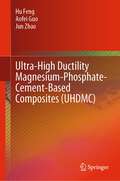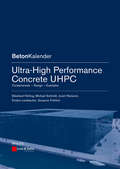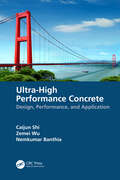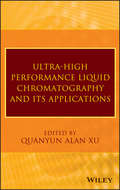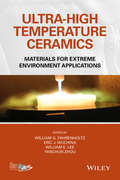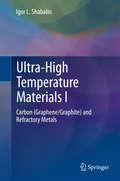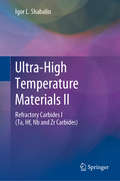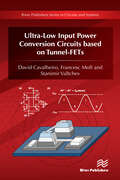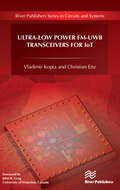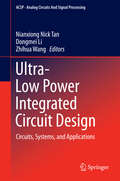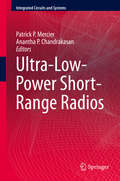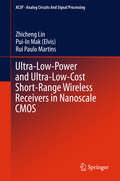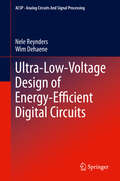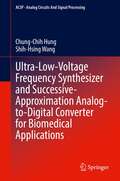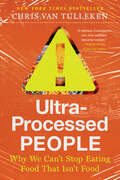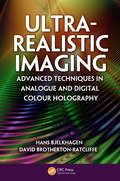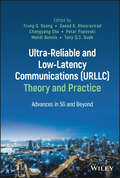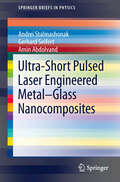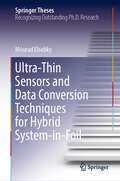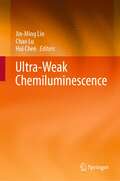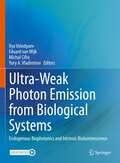- Table View
- List View
Ultra-High Ductility Magnesium-Phosphate-Cement-Based Composites (UHDMC)
by Jun Zhao Hu Feng Aofei GuoThis book systematically discusses the workability, mechanical properties, water stability, and material design methods of ultra-high ductility magnesium phosphate cement-based composites (UHDMC) with PVA fibers, PE fibers, or hybrid fibers. The developed UHDMC possesses strain-hardening behavior, multi-cracking, and ultra-high ultimate tensile strain, which can be used in many engineering projects, such as rapid repair and strengthening of airport runways, roads, bridges, and military installations. Meanwhile, this book covers the development of sprayable UHDMC, which further expands the application scope of UHDMC. This book is expected to provide some technical guidance for the development and design of UHDMC. The book is intended for graduate students who are interested in the ductility improvement of magnesium phosphate cement-based composites, researchers investigating the mechanical properties (strength, toughness, etc.), water stability, microstructure, and sprayabilityof magnesium phosphate cement-based composites, and engineers working on rapid repair of concrete structures.
Ultra-High Performance Concrete UHPC: Fundamentals, Design, Examples (Beton-Kalender Series)
by Michael Schmidt Ekkehard Fehling Joost Walraven Torsten Leutbecher Susanne FröhlichSelected chapters from the German concrete yearbook are now being published in the new English "Beton-Kalender Series" for the benefit of an international audience. Since it was founded in 1906, the Ernst & Sohn "Beton-Kalender" has been supporting developments in reinforced and prestressed concrete. The aim was to publish a yearbook to reflect progress in "ferro-concrete" structures until - as the book's first editor, Fritz von Emperger (1862-1942), expressed it - the "tempestuous development" in this form of construction came to an end. However, the "Beton-Kalender" quickly became the chosen work of reference for civil and structural engineers, and apart from the years 1945-1950 has been published annually ever since. Ultra high performance concrete (UHPC) is a milestone in concrete technology and application. It permits the construction of both more slender and more durable concrete structures with a prolonged service life and thus improved sustainability. This book is a comprehensive overview of UHPC - from the principles behind its production and its mechanical properties to design and detailing aspects. The focus is on the material behaviour of steel fibre-reinforced UHPC. Numerical modelling and detailing of the connections with reinforced concrete elements are featured as well. Numerous examples worldwide - bridges, columns, facades and roofs - are the basis for additional explanations about the benefits of UHPC and how it helps to realise several architectural requirements. The authors are extensively involved in the testing, design, construction and monitoring of UHPC structures. What they provide here is therefore a unique synopsis of the state of the art with a view to practical applications.
Ultra-High Performance Concrete: Design, Performance, and Application
by Caijun Shi Nemkumar Banthia Zemei WuUltra-high performance concrete (UHPC) is an advanced cement-based composite material with compressive strength of over 120 MPa, high toughness, and superior durability. Since its development in the early 1990s, UHPC has attracted great interest worldwide due to its advantages. This book covers material selection and mixture design methods for developing UHPC, as well as the performance of UHPC, including fresh and hardened properties, setting and hardening, dimensional stability, static and dynamic properties, durability, long-term properties, and self-healing properties.A range of potential applications and case studies are presented to illustrate how UHPC meets requirements for lightweight, high-rise, large-span, heavy-load bearing, fast-construction, and highly durable structures in civil and construction engineering. Also introduced is a typical new concrete, seawater sea-sand UHPC, which avoids the use of freshwater and river sand in marine construction.The first book to fully cover the design, performance, and applications of UHPC, this is ideal for concrete technologists, designers, contractors, and researchers.
Ultra-High Performance Liquid Chromatography and Its Applications
by Q. Alan XuExplores both the benefits and limitations of new UHPLC technology High performance liquid chromatography (HPLC) has been widely used in analytical chemistry and biochemistry to separate, identify, and quantify compounds for decades. The science of liquid chromatography, however, was revolutionized a few years ago with the advent of ultra-high performance liquid chromatography (UHPLC), which made it possible for researchers to analyze sample compounds with greater speed, resolution, and sensitivity. Ultra-High Performance Liquid Chromatography and Its Applications enables readers to maximize the performance of UHPLC as well as develop UHPLC methods tailored to their particular research needs. Readers familiar with HPLC methods will learn how to transfer these methods to a UHPLC platform and vice versa. In addition, the book explores a variety of UHPLC applications designed to support research in such fields as pharmaceuticals, food safety, clinical medicine, and environmental science. The book begins with discussions of UHPLC method development and method transfer between HPLC and UHPLC platforms. It then examines practical aspects of UHPLC. Next, the book covers: Coupling UHPLC with mass spectrometry Potential of shell particles in fast liquid chromatography Determination of abused drugs in human biological matrices Analyses of isoflavones and flavonoids Therapeutic protein characterization Analysis of illicit drugs The final chapter of the book explores the use of UHPLC in drug metabolism and pharmacokinetics studies for traditional Chinese medicine. With its frank discussions of UHPLC's benefits and limitations, Ultra-High Performance Liquid Chromatography and Its Applications equips analytical scientists with the skills and knowledge needed to take full advantage of this new separation technology.
Ultra-High Temperature Ceramics: Materials for Extreme Environment Applications
by Yanchun Zhou William G. Fahrenholtz William E. Lee Eric J. WuchinaThe first comprehensive book to focus on ultra-high temperature ceramic materials in more than 20 years Ultra-High Temperature Ceramics are a family of compounds that display an unusual combination of properties, including extremely high melting temperatures (>3000°C), high hardness, and good chemical stability and strength at high temperatures. Typical UHTC materials are the carbides, nitrides, and borides of transition metals, but the Group IV compounds (Ti, Zr, Hf) plus TaC are generally considered to be the main focus of research due to the superior melting temperatures and stable high-melting temperature oxide that forms in situ. Rather than focusing on the latest scientific results, Ultra-High Temperature Ceramics: Materials for Extreme Environment Applications broadly and critically combines the historical aspects and the state-of-the-art on the processing, densification, properties, and performance of boride and carbide ceramics. In reviewing the historic studies and recent progress in the field, Ultra-High Temperature Ceramics: Materials for Extreme Environment Applications provides: Original reviews of research conducted in the 1960s and 70s Content on electronic structure, synthesis, powder processing, densification, property measurement, and characterization of boride and carbide ceramics. Emphasis on materials for hypersonic aerospace applications such as wing leading edges and propulsion components for vehicles traveling faster than Mach 5 Information on materials used in the extreme environments associated with high speed cutting tools and nuclear power generation Contributions are based on presentations by leading research groups at the conference "Ultra-High Temperature Ceramics: Materials for Extreme Environment Applications II" held May 13-19, 2012 in Hernstein, Austria. Bringing together disparate researchers from academia, government, and industry in a singular forum, the meeting cultivated didactic discussions and efforts between bench researchers, designers and engineers in assaying results in a broader context and moving the technology forward toward near- and long-term use. This book is useful for furnace manufacturers, aerospace manufacturers that may be pursuing hypersonic technology, researchers studying any aspect of boride and carbide ceramics, and practitioners of high-temperature structural ceramics.
Ultra-High Temperature Materials I
by Igor L. ShabalinThis exhaustive work in three volumes with featuring cross-reference system provides a thorough overview of ultra-high temperature materials - from elements and chemical compounds to alloys and composites. Topics included are physical (crystallographic, thermodynamic, thermo-physical, electrical, optical, physico-mechanical, nuclear) and chemical (solid-state diffusion, interaction with chemical elements and compounds, interaction with gases, vapours and aqueous solutions) properties of the individual physico-chemical phases and multi-phase materials with melting (or sublimation) points over or about 2500 °C. The first volume focuses on carbon (graphite/graphene) and refractory metals (W, Re, Os, Ta, Mo, Nb, Ir). The second and third volumes are dedicated solely to refractory (ceramic) compounds (oxides, nitrides, carbides, borides, silicides) and to the complex materials - refractory alloys, carbon and ceramic composites, respectively. It will be of interest to researchers, engineers, postgraduate, graduate and undergraduate students in various disciplines alike. The reader is provided with the full qualitative and quantitative assessment for the materials, which could be applied in various engineering devices and environmental conditions at ultra-high temperatures, on the basis of the latest updates in the field of physics, chemistry, materials science, nanotechnology and engineering.
Ultra-High Temperature Materials II: Refractory Carbides I (Ta, Hf, Nb and Zr Carbides)
by Igor L. ShabalinThis exhaustive work in three volumes and over 1300 pages provides a thorough treatment of ultra-high temperature materials with melting points over 2500 °C. The first volume focuses on Carbon and Refractory Metals, whilst the second and third are dedicated solely to Refractory compounds and the third to Refractory Alloys and Composites respectively. Topics included are physical (crystallographic, thermodynamic, thermo physical, electrical, optical, physico-mechanical, nuclear) and chemical (solid-state diffusion, interaction with chemical elements and compounds, interaction with gases, vapours and aqueous solutions) properties of the individual physico-chemical phases of carbon (graphite/graphene), refractory metals (W, Re, Os, Ta, Mo, Nb, Ir) and compounds (oxides, nitrides, carbides, borides, silicides) with melting points in this range. It will be of interest to researchers, engineers, postgraduate, graduate and undergraduate students alike. The reader is provided with the full qualitative and quantitative assessment for the materials, which could be applied in various engineering devices and environmental conditions at ultra-high temperatures, on the basis of the latest updates in the field of physics, chemistry, materials science and engineering.
Ultra-Low Input Power Conversion Circuits based on Tunnel-FETs (River Publishers Series In Circuits And Systems Is A Series Of Comprehensive Academic And Professional Books Which Focus On Theory And Applications Of Circuit And Systems. This Includes Analog And Digital Integrated Circuits, Memory Technologies, System-on-chip And Processor Design. The Series Also Includes Books On Electronic Design Automation And Design Methodology, As Well As Computer Aided Des)
by Francesc Moll David Cavalheiro Stanimir ValtchevThe increasing demand in electronic portability imposes low power consumption as a key metric to analog and digital circuit design. Tunnel FET (TFET) devices have been explored mostly in digital circuits, showing promising results for ultra-low power and energy efficient circuit applications. The TFET presents a low inverse sub-threshold slope (SS) that allows a low leakage energy consumption, desirable in many digital circuits, especially memories.In this book, the TFET is explored as an alternative technology also for ultra-low power and voltage conversion and management circuits, suitable for weak energy harvesting (EH) sources. The TFET distinct electrical characteristics under reverse bias conditions require changes in conventional circuit topologies. In this book, ultra-low input power conversion circuits based on TFETs are designed and analyzed, evaluating their performance as rectifiers, charge pumps and power management circuits (PMC) for RF and DC EH sources.
Ultra-Low Power FM-UWB Transceivers for IoT (River Publishers Series In Circuits And Systems Is A Series Of Comprehensive Academic And Professional Books Which Focus On Theory And Applications Of Circuit And Systems. This Includes Analog And Digital Integrated Circuits, Memory Technologies, System-on-chip And Processor Design. The Series Also Includes Books On Electronic Design Automation And Design Methodology, As Well As Computer Aided Des)
by Vladimir Kopta Christian EnzOver the past two decades we have witnessed the increasing popularity of the internet of things. The vision of billions of connected objects, able to interact with their environment, is the key driver directing the development of future communication devices. Today, power consumption as well as the cost and size of radios remain some of the key obstacles towards fulfilling this vision. Ultra-Low Power FM-UWB Transceivers for IoT presents the latest developments in the field of low power wireless communication. It promotes the FM-UWB modulation scheme as a candidate for short range communication in different IoT scenarios. The FM-UWB has the potential to provide exactly what is missing today. This spread spectrum technique enables significant reduction in transceiver complexity, making it smaller, cheaper and more energy efficient than most alternative options.The book provides an overview of both circuit-level and architectural techniques used in low power radio design, with a comprehensive study of state-of-the-art examples. It summarizes key theoretical aspects of FM-UWB with a glimpse at potential future research directions. Finally, it gives an insight into a full FM-UWB transceiver design, from system level specifications down to transistor level design, demonstrating the modern power reduction circuit techniques.Ultra-Low Power FM-UWB Transceivers for IoT is a perfect text and reference for engineers working in RF IC design and wireless communication, as well as academic staff and graduate students engaged in low power communication systems research.
Ultra-Low Power Integrated Circuit Design
by Zhihua Wang Nianxiong Nick Tan Dongmei LiThis book describes the design of CMOS circuits for ultra-low power consumption including analog, radio frequency (RF), and digital signal processing circuits (DSP). The book addresses issues from circuit and system design to production design, and applies the ultra-low power circuits described to systems for digital hearing aids and capsule endoscope devices. Provides a valuable introduction to ultra-low power circuit design, aimed at practicing design engineers; Describes all key building blocks of ultra-low power circuits, from a systems perspective; Applies circuits and systems described to real product examples such as hearing aids and capsule endoscopes.
Ultra-Low-Power Short-Range Radios
by Patrick P. Mercier Anantha P. ChandrakasanThis book explores the design of ultra-low-power radio-frequency integrated circuits (RFICs), with communication distances ranging from a few centimeters to a few meters. The authors describe leading-edge techniques to achieve ultra-low-power communication over short-range links. Many different applications are covered, ranging from body-area networks to transcutaneous implant communications and smart-appliance sensor networks. Various design techniques are explained to facilitate each of these applications.
Ultra-Low-Power and Ultra-Low-Cost Short-Range Wireless Receivers in Nanoscale CMOS
by Pui-In Mak Rui Paulo Martins Zhicheng LinThis book provides readers with a state-of-the-art description of techniques to be used for ultra-low-power (ULP) and ultra-low-cost (ULC), short-range wireless receivers. Readers will learn what is required to deploy these receivers in short-range wireless sensor networks, which are proliferating widely to serve the internet of things (IoT) for "smart cities. " The authors address key challenges involved with the technology and the typical tradeoffs between ULP and ULC. Three design examples with advanced circuit techniques are described in order to address these trade-offs, which special focus on cost minimization. These three techniques enable respectively, cascading of radio frequency (RF) and baseband (BB) circuits under an ultra-low-voltage (ULV) supply, cascading of RF and BB circuits in current domain for current reuse and a novel function-reuse receiver architecture, suitable for ULV and multi-band ULP applications such as the sub-GHz ZigBee.
Ultra-Low-Voltage Design of Energy-Efficient Digital Circuits
by Wim Dehaene Nele ReyndersThis book focuses on increasing the energy-efficiency of electronic devices so that portable applications can have a longer stand-alone time on the same battery. The authors explain the energy-efficiency benefits that ultra-low-voltage circuits provide and provide answers to tackle the challenges which ultra-low-voltage operation poses. An innovative design methodology is presented, verified, and validated by four prototypes in advanced CMOS technologies. These prototypes are shown to achieve high energy-efficiency through their successful functionality at ultra-low supply voltages.
Ultra-Low-Voltage Frequency Synthesizer and Successive-Approximation Analog-to-Digital Converter for Biomedical Applications (Analog Circuits and Signal Processing)
by Chung-Chih Hung Shih-Hsing WangThis book introduces the origin of biomedical signals and the operating principles behind them and introduces the characteristics of common biomedical signals for subsequent signal measurement and judgment. Since biomedical signals are captured by wearable devices, sensor devices, or implanted devices, these devices are all battery-powered to maintain long working time. We hope to reduce their power consumption to extend service life, especially for implantable devices, because battery replacement can only be done through surgery. Therefore, we must understand how to design low-power integrated circuits.Both implantable and in-vitro medical signal detectors require two basic components to collect and transmit biomedical signals: an analog-to-digital converter and a frequency synthesizer because these measured biomedical signals are wirelessly transmitted to the relevant receiving unit. The core unit of wireless transmission is the frequency synthesizer, which provides a wide frequency range and stable frequency to demonstrate the quality and performance of the wireless transmitter. Therefore, the basic operating principle and model of the frequency synthesizer are introduced. We also show design examples and measurement results of a low-power low-voltage integer-N frequency synthesizer for biomedical applications. The detection of biomedical signals needs to be converted into digital signals by an analog-to-digital converter to facilitate subsequent signal processing and recognition. Therefore, the operating principle of the analog-to-digital converter is introduced. We also show implementation examples and measurement results of low-power low-voltage analog-to-digital converters for biomedical applications.
Ultra-Processed People: The Science Behind Food That Isn't Food
by Chris van TullekenNew York Times Bestseller International Bestseller Finalist for the 2024 IACP Award for Food Issues & Matters An Economist Best Book of 2023 • One of Smithsonian's Ten Best Books About Food of 2023 • A Financial Times Best Food and Drink Book of 2023 • A New Yorker Best Books of 2023 So Far • A Goodreads Choice Awards 2023 Nominee • An NPR 2023 "Books We Love" Pick A manifesto to change how you eat and how you think about the human body. It’s not you, it’s the food. We have entered a new age of eating. For the first time in human history, most of our calories come from an entirely novel set of substances called Ultra-Processed Food. There’s a long, formal scientific definition, but it can be boiled down to this: if it’s wrapped in plastic and has at least one ingredient that you wouldn’t find in your kitchen, it’s UPF. These products are specifically engineered to behave as addictive substances, driving excess consumption. They are now linked to the leading cause of early death globally and the number one cause of environmental destruction. Yet almost all our staple foods are ultra-processed. UPF is our food culture and for many people it is the only available and affordable food. In this book, Chris van Tulleken, father, scientist, doctor, and award-winning BBC broadcaster, marshals the latest evidence to show how governments, scientists, and doctors have allowed transnational food companies to create a pandemic of diet-related disease. The solutions don’t lie in willpower, personal responsibility, or exercise. You’ll find no diet plan in this book—but join Chris as he undertakes a powerful self-experiment that made headlines around the world: under the supervision of colleagues at University College London he spent a month eating a diet of 80 percent UPF, typical for many children and adults in the United States. While his body became the subject of scientific scrutiny, he spoke to the world’s leading experts from academia, agriculture, and—most important—the food industry itself. But more than teaching him about the experience of the food, the diet switched off Chris’s own addiction to UPF. In a fast-paced and eye-opening narrative he explores the origins, science, and economics of UPF to reveal its catastrophic impact on our bodies and the planet. And he proposes real solutions for doctors, for policy makers, and for all of us who have to eat. A book that won’t only upend the way you shop and eat, Ultra-Processed People will open your eyes to the need for action on a global scale.
Ultra-Realistic Imaging: Advanced Techniques in Analogue and Digital Colour Holography
by Hans Bjelkhagen David Brotherton-RatcliffeUltra-high resolution holograms are now finding commercial and industrial applications in such areas as holographic maps, 3D medical imaging, and consumer devices. Ultra-Realistic Imaging: Advanced Techniques in Analogue and Digital Colour Holography brings together a comprehensive discussion of key methods that enable holography to be used as a te
Ultra-Reliable and Low-Latency Communications (URLLC) Theory and Practice: Advances in 5G and Beyond
by Mehdi Bennis Tony Q.S. Quek Trung Q. Duong Petar Popovski Saeed R. Khosravirad Changyang SheUltra-Reliable and Low-Latency Communications (URLLC) Theory and Practice Comprehensive resource presenting important recent advances in wireless communications for URLLC services, including device-to-device communication, multi-connectivity, and more Ultra-Reliable and Low-Latency Communications (URLLC) Theory and Practice discusses the typical scenarios, possible solutions, and state-of-the-art techniques that enable URLLC in different perspectives from the physical layer to higher-level approaches, aiming to tackle URLLC’s challenges with both theoretical and practical approaches, which bridges the lacuna between theory and practice. With long-term contributions to the development of future wireless networks, the text systematically presents a thorough study of the novel and innovative paradigm of URLLC; basic requirements are covered, along with essential definitions, state-of-the-art technologies, and promising research directions of URLLC. To aid in reader comprehension, tables, figures, design schematics, and examples are provided to illustrate abstract engineering concepts and make the text more accessible to a broader readership, and corresponding case studies are included in the last part of the book. Fundamental problems in URLLC, including designing building blocks for URLLC, radio resource management in URLLC, resource optimization, network availability guarantee, and coexisting with other future mobile networks, are also discussed. In Ultra-Reliable and Low-Latency Communications (URLLC) Theory and Practice, readers can expect to find detailed information on: BCH and analog codes, stable matching, OFDM demodulation and turbo coding, and semi-blind receivers for URLLC MIMO-NOMA with URLLC, PHY and MAC layer technologies for URLLC, and Network slicing or SDN for URLLC and eMBB Integrating theoretical knowledge into deep learning for URLLC, Energy-Latency tradeoff in URLLC, and Downlink transmission for URLLC under physical layer aspects Resource allocation for multi-user downlink URLLC, HARQ optimization for 5G URLLC, and Multi-Access edge computing with URLLC A unique resource with comprehensive yet accessible coverage of a complicated subject, Ultra-Reliable and Low-Latency Communications (URLLC) Theory and Practice is an ideal resource for a large and diverse population of researchers and practitioners in engineering, computer scientists, and senior undergraduate and graduate students in related programs of study.
Ultra-Short Pulsed Laser Engineered Metal-Glass Nanocomposites
by Amin Abdolvand Andrei Stalmashonak Gerhard SeifertGlasses containing metallic nanoparticles exhibit very promising linear and nonlinear optical properties, mainly due to the surface plasmon resonances (SPRs) of the nanoparticles. The spectral position in the visible and near-infrared range and polarization dependence of the SPR are characteristically determined by the nanoparticles' shapes. The focus of Ultra-Short Pulsed Laser Engineered Metal-Glass Nanocomposites is the interaction of intense ultra-short laser pulses with glass containing silver nanoparticles embedded in soda-lime glass, and nanostructural modifications in metal-glass nanocomposites induced by such laser pulses. In order to provide a comprehensive physical picture of the processes leading to laser-induced persistent shape transformation of the nanoparticles, series of experimental results investigating the dependences of laser assisted shape modifications of nanoparticles with laser pulse intensity, excitation wavelength, temperature are considered. In addition, the resulting local optical dichroism allows producing very flexibly polarizing optical (sub-) microstructures with well-specified optical properties. The achieved considerable progress towards technological application of this technique, in particular also for long-term optical data storage, is also discussed.
Ultra-Thin Sensors and Data Conversion Techniques for Hybrid System-in-Foil (Springer Theses)
by Mourad ElsobkyThis book reports on the design, fabrication and characterization of a set of flexible electronic components, including on-foil sensors, organic thin-film transistors and ultra-thin chips. The core of the work is on showing how to combine high-performance integrated circuits with large-area electronic components on a single polymeric foil, to realize smart electronic systems for different applications, such as temperature, humidity and mechanical stress sensors. The book offers an extensive introduction to Hybrid System-in-Foil technology (HySiF), and related on-chip/on-foil passive and active components. It presents six case studies designed to highlight key HySiF challenges, together with the methodology to address those challenges. Last but not least, it describes the development of a reconfigurable, energy-efficient Analog-to-Digital Converter for HySiF. All in all, this book provides readers with extensive information on the state of the art in the design and characterization of integrated circuits and hybrid electronic systems on flexible polymeric substrates. By describing significant advances in organic thin-film transistor technology, this work is expected to pave the way to future developments in the area of energy-efficient smart sensors and integrated circuits.
Ultra-Weak Chemiluminescence
by Jin-Ming Lin Hui Chen Chao LuThis book offers a complete and well-organized review of the latest advances made in developing ultra-weak chemiluminescence techniques for analytical applications. It systematically introduces the current theories, mechanisms, instruments, technologies, and real applications of ultra-weak chemiluminescence. Compared to books devoted to the normal chemiluminescence and bioluminescence, this book covers a wide range of ultra-weak chemiluminescence based on inorganic chemical reactions and nanotechnology from a principle and practical point of view. This book is intended for readers who are interested in expanding their knowledge of chemiluminescence and employing ultra-weak chemiluminescence techniques to develop new detection methods for analytical applications.
Ultra-Weak Photon Emission from Biological Systems: Endogenous Biophotonics and Intrinsic Bioluminescence
by Ilya Volodyaev Eduard Van Wijk Michal Cifra Yury A. VladimirovThis book addresses the phenomenon of biological autoluminescence (also known as ultraweak photon emission, UPE, biochemiluminescence, or biophotons) and deals with a very broad spectrum of subjects, ranging from basic observational studies to molecular mechanisms, free-radical processes, physics of electron excitation and photon emission, as well as detection techniques. The chapter topics include UPE in plants, animals, and the human body; microorganisms and subcellular structures; and model systems, illustrating its high prevalence. Several sections of the book provide some backstory, with emphasis on methodology, unresolved questions, and existing controversies. The authors raise and discuss complex, potentially divisive aspects: Are there any reasons to assume the existence of non-chemical interaction in biological systems? Can research results in the field of mitogenetic radiation, delayed luminescence, and oxychemiluminescence of model systems, be correctly interpreted? What does the future hold for this area of research? Altogether, this publication gives the reader a thorough overview of biological autoluminescence (UPE, biophotonics) research, making it ideal for students and researchers who are new to the area as well as those who are specializing in it.
Ultra-Wideband RF System Engineering
by Aptara. Inc Thomas ZwickThis comprehensive summary of the state of the art in Ultra Wideband (UWB) system engineering takes you through all aspects of UWB design, from components through the propagation channel to system engineering aspects. Mathematical tools and basics are covered, allowing for a complete characterisation and description of the UWB scenario, in both the time and the frequency domains. UWB MMICs, antennas, antenna arrays, and filters are described, as well as quality measurement parameters and design methods for specific applications. The UWB propagation channel is discussed, including a complete mathematical description together with modeling tools. A system analysis is offered, addressing both radio and radar systems, and techniques for optimization and calibration. Finally, an overview of future applications of UWB technology is presented. Ideal for scientists as well as RF system and component engineers working in short range wireless technologies.
Ultra-Wideband Radio Frequency Identification Systems
by Farid Dowla Faranak NekoogarUltra-wideband Radio Frequency Identification Systems describes the essentials of radio frequency identification (RFID)systems as well as their target markets. The book covers a study of commercially available RFID systems and characterizes their performance in terms of read range and reliability in the presence of conductive and dielectric materials. The capabilities and limitations of commercial RFID systems are reported followed by comprehensive discussions of the advantages and challenges of using ultra-wideband (UWB) technology for tag/reader communications. The book presents practical aspects of RFID system such as: EPC global and ISO standards, implementation, and target markets in a simple and easy to understand language.
Ultra-Wideband Radio Propagation Channels: A Practical Approach
by Pascal Pagani Friedman Tchoffo Talom Bernard Uguen Patrice PajuscoUltra Wide Band (UWB) technology consists of transmitting radio signals over frequency bandwidths from 500 MHz to several GHz. Its unique characteristics may be exploited for the design of high data rate wireless communication systems, as well as localization and imaging applications. The development and optimization of such systems require a precise knowledge of the radio transmission medium. This book examines all aspects of the propagation channel for UWB systems. UWB technology is first presented, with a particular emphasis being placed on its applications, spectrum regulation issues, and the different communication techniques. The authors introduce the theoretical bases of radioelectric propagation and give an overview of the channel sounding techniques adapted for UWB signals. The two main principles of UWB channel modeling are finally exposed and illustrated: deterministic channel modeling, based on the simulation of the propagation phenomena in a given environment, and statistical channel modeling, which relies on the experimental analysis of the main channel characteristics.
Ultra-Wideband and 60 GHz Communications for Biomedical Applications
by Mehmet R. Yuce This book investigates the design of devices, systems, and circuits for medical applications using the two recently established frequency bands: ultra-wideband (3. 1-10. 6 GHz) and 60 GHz ISM band. These two bands provide the largest bandwidths available for communication technologies and present many attractive opportunities for medical applications. The applications of these bands in healthcare are wireless body area network (WBAN), medical imaging, biomedical sensing, wearable and implantable devices, fast medical device connectivity, video data transmission, and vital signs monitoring. The recent technological advances and developments proposed or used in medicine based on these two bands are covered. The book introduces possible solutions and design techniques to efficiently implement these systems in medical environment. All individual chapters are written by leading experts in their fields. Contributions by authors are on various applications of ultra-wideband and the 60 GHz ISM band including circuit implementation, UWB and 60 GHz signal transmission around and in-body, antenna design solution, hardware implementation of body sensors, UWB transceiver design, 60 GHz transceiver design, UWB radar for contactless respiratory monitoring, and ultra-wideband based medical Imaging. The book will be a key resource for medical professionals, bio-medical engineers, and graduate and senior undergraduate students in computer, electrical, electronic and biomedical engineering disciplines.
